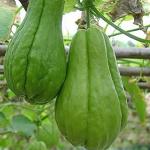Growing Choko/Chayote, also Chayote squash, christophene, chouchou, mirliton
Sechium edule : Cucurbitaceae / the gourd family
| Jan | Feb | Mar | Apr | May | Jun | Jul | Aug | Sep | Oct | Nov | Dec |
|---|
Not recommended for growing in USA - Zone 5a regions
- Easy to grow. Plant whole mature fruit when one produces a shoot at one end.. Best planted at soil temperatures between 59°F and 86°F.
- Space plants: 39 inches apart
- Harvest in 17-25 weeks. Best when fruit is light green and not more than 6 cm long.
- Compatible with (can grow beside): Cucumbers
Choko is only suitable for warmer climates but frequent hot nights will slow flowering. Fruit production is highest when night temperatures range from 59 - 68 F (15 - 20 C). Plant in a warm, unused corner of the garden. Leave the shoot sticking out of the ground and it will take off. Choko needs a long growing season, about 4 - 6 months but in that time it will spread and can be useful to cover old sheds or fences!
An average household would need one or two plants.
Leaves rather like cucumber and some prickles on the fruit. Some variation in fruit, with lighter green and few prickles depending on variety. The differences seem to be between countries eg. USA, Australia, Malta.
Culinary hints - cooking and eating Choko/Chayote
Chokos can be peeled and chopped to use in stews, soup or as a stir fry vegetable.
Cooked or raw, it has a very mild flavour and is commonly served with seasonings eg. salt, butter and pepper or in a dish with other vegetables and/or flavourings. It can also be boiled, stuffed, mashed or pickled.


Your comments and tips